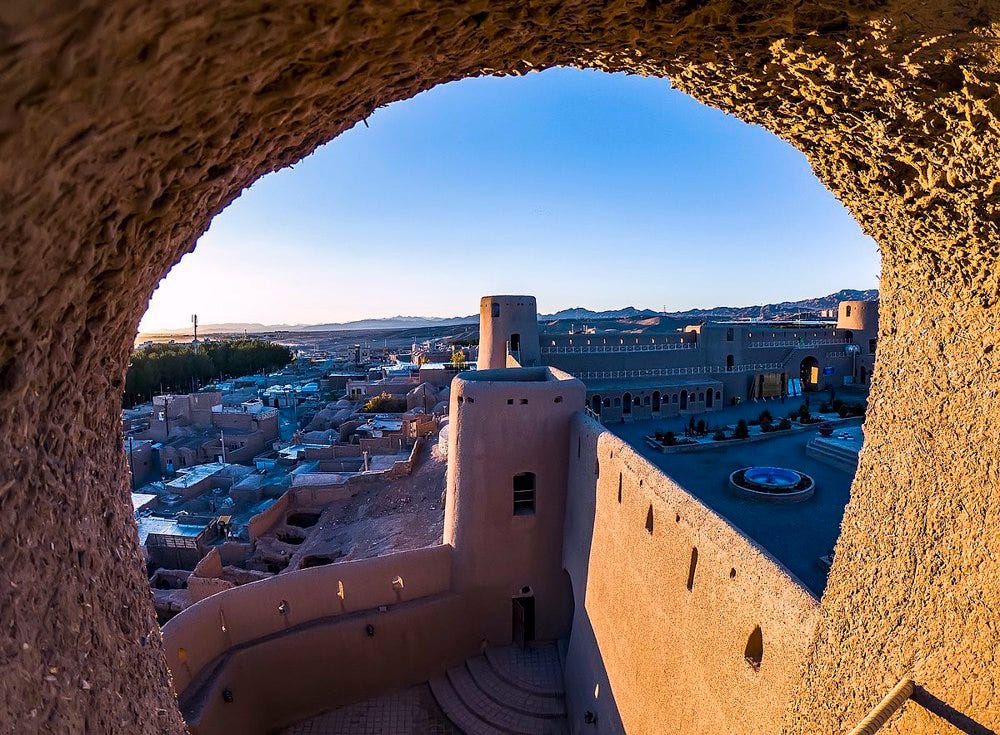Birjand Castle: Where Stone Meets Spirit
Exploring the Cultural Heart of South Khorasan
Tucked between the saffron fields and desert winds of South Khorasan, Birjand Castle rises like a silent guardian over centuries of Iranian faith and culture. What was once a fortress of war has become a fortress of memory — a place where history, architecture, and spirituality meet under the same golden sky.
For travellers tracing the deeper story of Iran — not just through its shrines and mosques, but through its living heritage — Birjand Castle offers more than a scenic stop. It is a testament to resilience, a reminder that the same hands that built fortresses also carved the arches of mosques, raised domes to the heavens, and crafted a civilization rooted in divine beauty.
A Fortress Carved from Faith and Clay
Perched on Mahour Hill, the castle dates back to the Safavid era, its structure built from humble materials — brick, mud, and straw — yet engineered with astonishing precision. Its eight towers, circular ramparts, and hidden escape tunnels once protected the people of Birjand from invading forces.
Standing atop its ramparts today, one can still feel the echo of that protection — not only of territory, but of identity. Like the hearts of believers that withstood trials through faith, the walls of this fortress withstood the storms of time.
The View from Above
From the top of Birjand Castle, the city stretches out like a tapestry of sand and saffron. The call to prayer echoes softly from nearby mosques, mingling with the scent of rosewater drifting from the bazaars below.
It’s easy to imagine how this same view once gave solace to travellers crossing Iran’s ancient trade routes — those who paused here not just for rest, but for reflection.
For pilgrims journeying through Iran’s eastern lands — perhaps on their way to Mashhad, Qa’en, or Tabas — Birjand offers a chance to slow down, breathe, and see how the faith that fills the shrines also breathes through the walls of the old cities.
Beyond a Fortress: A Cultural Sanctuary
Once a stronghold of defense, the castle has now become a centre of preservation. Its restored courtyard hosts exhibitions of local handicrafts, traditional textiles, and handmade leatherwork, showcasing the craftsmanship of the very people it once protected.
Here, the story of Iran unfolds — not only in its glorious shrines, but also in its cultural roots. Pilgrimage in Iran is never just about visiting sacred sites; it is about connecting the dots between the spiritual and the cultural, between devotion and creation.
Journey with Purpose
At Shia Journeys, we believe every step through Iran is a step through history and faith. Our itineraries are designed to let you explore places like Birjand Castle not merely as a tourist, but as a pilgrim of heritage.
From arranging guided tours of the castle and its surrounding bazaars, to connecting your route toward Mashhad or the holy shrines of Qom, our goal is to let you experience Iran as it was meant to be seen — through the lens of meaning, memory, and devotion.
Let the ramparts of Birjand Castle remind you: every stone in Iran has a story, and every journey here is a form of worship.
Why Visit Birjand Castle
Architectural beauty: Elegant Safavid design with defensive towers, inner courtyards, and panoramic desert views.
Cultural immersion: Handicraft exhibitions and local artisans keep the traditions of Qahestan alive.
Spiritual depth: A pause for reflection between sacred destinations — linking the cultural heart of South Khorasan with the spiritual heart of Mashhad.
Historical insight: Once a stronghold guarding trade routes, now a living museum of Iran’s resilience.
Plan Your Journey
Whether you’re tracing the spiritual routes of the Ahl al-Bayt (AS) or exploring Iran’s architectural jewels, Shia Journeys can curate a route that connects your pilgrimage with Iran’s cultural soul — from Birjand Castle’s ancient towers to the golden dome of Imam Ridha (AS).
Every step, a story.
Every landmark, a lesson.
Every journey, a remembrance.



